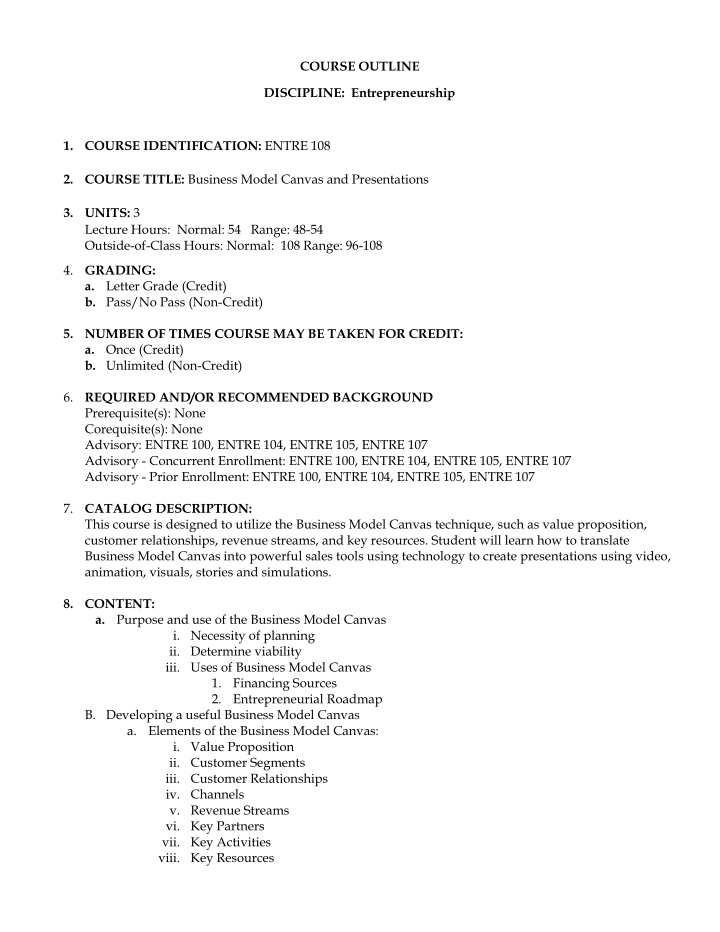



COURSE OUTLINE DISCIPLINE: Entrepreneurship 1. COURSE IDENTIFICATION: ENTRE 108 2. COURSE TITLE: Business Model Canvas and Presentations 3. UNITS: 3 Lecture Hours: Normal: 54 Range: 48-54 Outside-of-Class Hours: Normal: 108 Range: 96-108 4. GRADING: a. Letter Grade (Credit) b. Pass/No Pass (Non-Credit) 5. NUMBER OF TIMES COURSE MAY BE TAKEN FOR CREDIT: a. Once (Credit) b. Unlimited (Non-Credit) 6. REQUIRED AND/OR RECOMMENDED BACKGROUND Prerequisite(s): None Corequisite(s): None Advisory: ENTRE 100, ENTRE 104, ENTRE 105, ENTRE 107 Advisory - Concurrent Enrollment: ENTRE 100, ENTRE 104, ENTRE 105, ENTRE 107 Advisory - Prior Enrollment: ENTRE 100, ENTRE 104, ENTRE 105, ENTRE 107 7. CATALOG DESCRIPTION: This course is designed to utilize the Business Model Canvas technique, such as value proposition, customer relationships, revenue streams, and key resources. Student will learn how to translate Business Model Canvas into powerful sales tools using technology to create presentations using video, animation, visuals, stories and simulations. 8. CONTENT: a. Purpose and use of the Business Model Canvas i. Necessity of planning ii. Determine viability iii. Uses of Business Model Canvas 1. Financing Sources 2. Entrepreneurial Roadmap B. Developing a useful Business Model Canvas a. Elements of the Business Model Canvas: i. Value Proposition ii. Customer Segments iii. Customer Relationships iv. Channels v. Revenue Streams vi. Key Partners vii. Key Activities viii. Key Resources
ix. Cost Structure C. Translating a Business Model Canvas into a powerful presentation i. What investors want to know D. Types of presentations i. Informative ii. Demonstrative iii. Inspirational iv. Persuasive E. Elevator Pitch, full presentations, Videos i. Funding ii. Sales F. Commonly used presentation software i. PowerPoint ii. Prezi iii. Canva iv. Slidebeam 9. OBJECTIVES: a. Understand the key components of the Business Model Canvas b. Collect market-driven (primary and secondary) data to be used for a Business Model Canvas c. Develop a Business Model Canvas d. Give two types of presentations e. Professionally respond to challenging questions f. Create an engaging and impressive presentation that tells a story g. Create a two to three-minute pitch video 10. METHODS OF INSTRUCTION – May include any of the following: a. Lecture b. Guest speakers c. Internet instruction d. Collaborative group work e. Web-based presentations f. Outside research g. Small group or directed class discussions h. Student-instructor conferences i. Study groups j. Audio visual presentations k. Field trips 11. OUT-OF-CLASS ASSIGNMENTS – May include any of the following: a. READING: Students will read course materials pertaining to creating a Business Model Canvas and presentation strategies. b. WRITING: Students will create a Business Model Canvas. c. CRITICAL THINKING: Students will convert a Business Model Canvas into a commonly used presentation. 12. METHODS OF EVALUATION – May include any of the following: a. Grading scale specified in the course syllabus b. Analytical projects c. Application of knowledge/skill d. Class presentations
e. Completion of homework assignments f. Creative projects g. Demonstrated ability h. Essay exams i. Essays j. Group projects k. Journals l. Notebooks m. Oral reports n. Participation in classroom discussion o. Portfolios p. Problem sets q. Research papers r. Research projects s. Simulations t. Written essays, reports 13. RECOMMENDED TEXTS AND SUPPORTING REFERENCES: a. TEXT: i. Duarte, Nancy. Resonate: Present Visual Stories that Transform Audiences. 1 st edition. John Wiley and Sons. 2010. ii. Coughter, Peter. The Art of the Pitch. 2012 (ebook – Free) Klaff, Oren. Pitch Anything: An Innovative Method for Presenting, Persuading, and iii. Winning the Deal. 2011 iv. b. OTHER: i. YouTube.com: Strategizer Business Model Canvas Videos ii. Shark Tank- Television Show iii. Strategizer.com iv. Fred E. Miller and Charles Manion. No Sweat Elevator Speech!: How to Craft Your Elevator Speech, Floor by Floor, with no Sweat!. Feb 21, 2014
Recommend
More recommend